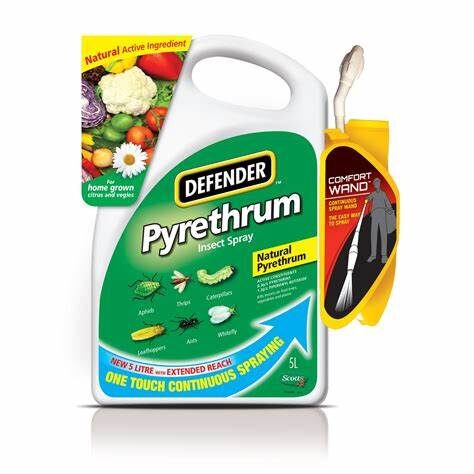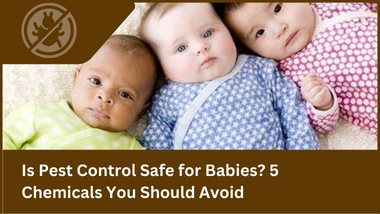As a parent, your baby’s safety is your top priority, especially when dealing with unwanted pests in the home. While effective pest control is essential, it’s natural to wonder, “Is pest control safe for babies or toddler?”
In this article, we’ll explore the potential health risks of using certain pesticides and chemicals around infants. More importantly, we’ll show you safer alternatives to ensure your pest control methods are safe around young children.
Is Pest Control Safe for Babies?
When considering pest control, the key question is whether the products and methods used are safe around children and babies. Pesticides pose dangers to babies no matter the type, thus should not be around babies.
Exposure to certain pest control chemicals has been linked to respiratory problems, skin irritation, and even developmental issues in young children.
Here are five pesticides you should avoid when conducting pest control around infants, toddlers, and babies:
1. Organophosphates
Organophosphates are a group of pesticides that inhibit the activity of certain enzymes necessary for proper nerve function. Commonly used to control a variety of pests, including ants, cockroaches, and termites, they are highly effective but also highly toxic.
- Health Risks:
- Neurological Damage: Organophosphate exposure can lead to developmental delays, especially in infants and toddlers. Symptoms may include headaches, dizziness, nausea, and in severe cases, coma.
- Respiratory Issues: Exposure can trigger asthma attacks or respiratory distress, particularly in young children whose lungs are still developing.
- Skin and Eye Irritation: Direct contact can cause rashes, irritation, and burning sensations in sensitive skin.
- Safer Alternatives:
- Consider using biological pest control methods that introduce natural predators like ladybugs to keep pests in check.
- Non-toxic options like diatomaceous earth can also help control pest populations effectively without introducing harmful chemicals.
2. Pyrethroids

Pyrethroids are synthetic chemicals modeled after pyrethrins, which are derived from chrysanthemum flowers. While marketed as a safer alternative, pyrethroids can still pose health risks, particularly when misused.
- Health Risks:
Allergic Reactions: Infants can experience allergic reactions, including skin irritation and respiratory distress.
Endocrine Disruption: There is ongoing research about the potential of pyrethroids to disrupt hormonal systems, which can lead to developmental issues in young children.
Increased Sensitivity: Children are often more sensitive to pesticides due to their smaller body sizes, making even low levels of exposure risky.
Safer Alternatives:
opt for natural insect repellents, such as essential oils like peppermint or clove, which can deter pests without harmful side effects.
Regular cleaning and maintenance, such as sealing entry points, can help prevent pest infestations without the need for harsh chemicals.
3. Carbamates

Carbamates are a class of pesticides that disrupt the normal functioning of the nervous system. Often used in sprays for controlling pests like roaches and ants, their use comes with notable risks.
- Health Risks:
- Acute Poisoning: Ingestion or inhalation of carbamates can lead to symptoms like sweating, salivation, vomiting, and diarrhea, particularly in children.
- Long-Term Effects: Prolonged exposure may increase the risk of respiratory problems and can affect brain development in infants and toddlers.
- Increased Vulnerability: Children are particularly susceptible to the toxic effects due to their smaller body weight and developing systems.
- Safer Alternatives:
- Integrated pest management (IPM) techniques, such as maintaining cleanliness and reducing food sources for pests, can minimize the need for chemical interventions.
- Consider using non-toxic bait stations designed for household pests, which can be placed out of reach of children.
4. Fipronil

Fipronil is a broad-spectrum insecticide used primarily for termites, ants, and fleas. Its mechanism of action affects the central nervous system of insects, but it can also pose serious health risks to humans and animals.
- Health Risks:
- Skin and Eye Irritation: Fipronil can cause severe irritation upon contact, particularly for toddlers who may touch treated surfaces and then touch their faces.
- Potential for Toxic Accumulation: This chemical can bioaccumulate in the body, leading to long-term health effects, including thyroid issues and reproductive toxicity.
- Environmental Concerns: Fipronil is known to affect aquatic ecosystems, posing indirect health risks to children who play near treated areas.
- Safer Alternatives:
- Use boric acid or diatomaceous earth as alternatives for managing pest populations. These substances are less toxic and can be effective against common household pests.
- Choose pest control methods that employ baits instead of sprays, as they can target pests directly and minimize the risk of exposure to children.
5. Boric Acid
While often considered a safer option, boric acid can still be hazardous if misused. It’s frequently found in various pest control products, including roach and ant baits.
- Health Risks:
- Toxicity in High Doses: Ingesting large amounts can lead to severe gastrointestinal distress, and infants are particularly susceptible due to their small size.
- Respiratory Issues: Dust from boric acid can irritate the respiratory tract when inhaled, especially for children with existing asthma or respiratory conditions.
- Environmental Impact: Excessive use can harm beneficial insects and disrupt local ecosystems.
- Safer Alternatives:
- Implement preventive measures such as sealing food and keeping areas clean to deter pests without using chemicals.
- Consider non-toxic traps or natural deterrents like essential oils to keep pests at bay while minimizing health risks.
- Professional Pest Control Services
When opting for pest control services, ensure you select professional pest control companies that specialize in safe pest control methods. Many companies now offer eco-friendly solutions that are safe for babies.
The Importance of Safe Pest Control Around Babies
Pests such as ants, roaches, and rodents can pose serious health risks to your family. However, traditional pest control treatments often involve chemicals that can be toxic to infants.
Children are more vulnerable to the harmful effects of pesticides because their bodies are still developing, and they are more likely to come into contact with treated surfaces by crawling, touching, or playing on the floor. Pesticide residue can linger in areas of the home, increasing the risk of exposure.
Newborn babies and young children are particularly sensitive to toxic chemicals. For parents raising young ones, it is crucial to choose safe pest control methods that will protect your family without compromising health.
Conclusion
Pest control doesn’t mean you should compromise the safety of your family. By avoiding toxic chemicals like organophosphates and pyrethroids and opting for safe pest control methods, you will be able to protect your babies and children from harmful chemicals.
For homeowners raising young children, it’s crucial to stay informed about the type of pesticides used in your home. Choose pest control options that safeguard both your family and the environment while efficiently managing unwanted pests.
